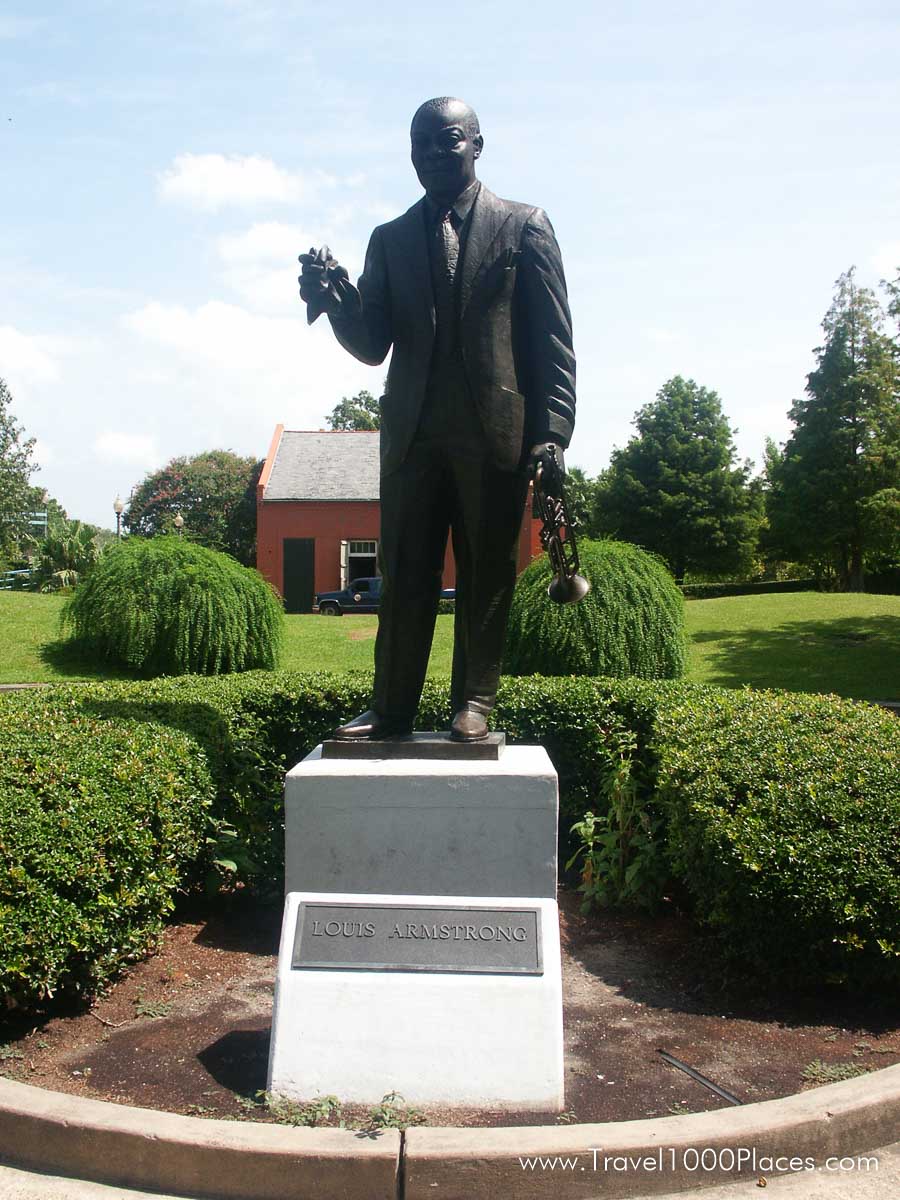![Louis Armstrong, 1953 (Library of Congress Archives, World-Telegram staff photographer [Public domain])](https://www.travel1000places.com/wp-content/uploads/2022/05/wikimedia-Louis_Armstrong-public-domain-1200px.jpg)

Louis ‘Satchmo’ Armstrong – a piece of jazz history
Childhood
Historians argue about when the legendary entertainer and jazz musician was born. What is certain is that he was born in New Orleans, the son of Mayanne (Mary Ann) and Willie Armstrong.
Armstrong himself always gave the American Independence Day, i.e. July 4, in 1900 as the day of his birth. He also had this date entered in the birth register in 1918. Several of his first companions even thought Armstrong was born in 1898, anyway, the latest research has come to the conclusion that Louis Armstrong was born on August 4, 1901. Someone also wanted to know that his middle name was Daniel. Armstrong, however, always denied this.
Father and mother Armstrong separated shortly after his birth and little Louis grew up with his grandmother (paternal) Josephine. After the birth of his sister, Louis was about five years old, Louis moved with his sister to his mother, who lived in a not exactly recalcitrant residential area. Childhood passed without much love and the family lived in poverty. Louis probably suffered from the withdrawal of love, which burdened him psychologically. Despite this difficult childhood, Armstrong did not speak with bitterness about this time in later years. He learned a lot about life from the prostitutes, the pimps, the gamblers and artists in the neighborhood – things that are not taught in any school. To make money, Armstrong sang on a street corner for a few cents, or he sold newspapers; he was also in demand as a messenger boy. All in all, Armstrong learned to live and survive in this environment, and one understands why he was later only interested in making money.
New style of music
At that time, a new style of music developed in pubs and honky-tonks of New Orleans. Wherever this sound set the tone, the venues were crowded. The bands were mostly small with a maximum of four musicians, but Armstrong also saw and heard Dixieland bands in which up to seven musicians shaped the classic New Orleans style. So, Louis Armstrong got access to music at an early age, and he was captivated by it. He decided to make a career as a musician.
Beginning of the career
But he was just too poor to buy an instrument.
On New Year’s Eve 1912, Armstrong was arrested for a forbidden New Year’s Eve fireworks and sent to an institution for hard-to-educate youth. That was his luck, because here he finally found the longed-for access to his music. First, he devoured literature about jazz in the institution’s library. The director of the institution promoted his interest in music and put him into the institution’s band, where he was taught the first notes and a certain technique on a brass instrument by the bandleader Peter Davis. After his release in June 1914, he worked during the day with various local bands in the Honky Tonks of New Orleans. In these bands he played on a borrowed horn. From his first self-earned money, he bought a badly dented brass instrument and taught himself the technique through ‘learning by doing’ – at the same time he supported his mother and sister.
Mentors
One of his first mentors was the cornetist and trumpeter Joseph (Joe) “King” Oliver, who was one of the best in the scene. Unfortunately, the two men’s views of music were very different. At the time, Oliver was the co-leader of a band assembled by Edward “Kid” Ory that had been voted the best jazz band in New Orleans. Many jazz musicians were drawn to Chicago or the West Coast around this time, because the clubs paid better, among other things. Oliver also went to Chicago in 1918. He agreed with Armstrong that Satchmo should take over the ory combo during his absence. Armstrong saw this as his chance. He seized the opportunity and quickly became the “coming man” of jazz. He established himself at performances on the famous Riverboats and played more and more often in the better pubs of New Orleans, with better and better musicians. In 1918 he married Daisy Parker, a former prostitute.
Chicago
In 1922 Joseph “King” Oliver brought him to Chicago and Armstrong played as a ‘second’ cornetist in the legendary “Creole Jazz Band”. However, he was given the opportunity to interpret pieces in his style. Especially with the piece “Froggie Moore” he gained great recognition from the audience and band.
Marriage Number Two
In Chicago, Armstrong met Lillian Hardin, who played piano in the Oliver Band, and a little later fell in love. In 1923 he divorced his first wife and the following year he married Lillian, who came from the black middle class and had completed an education in classical music. It was she who recognized Armstrong’s extraordinary talent and from then on promoted it. First of all, Armstrong had to detach himself from the shadow of Oliver, as she said.
New York
She went with Louis to New York City in September 1924 to not waste his talent. It was the Fletcher Henderson Band in which Armstrong demonstrated his great skills from 1924 onwards. He set himself apart from others with his technique, his intense swing and the imaginative structure of his melodic style.
Armstrong quickly became the much admired and courted musician of his time in the world.

